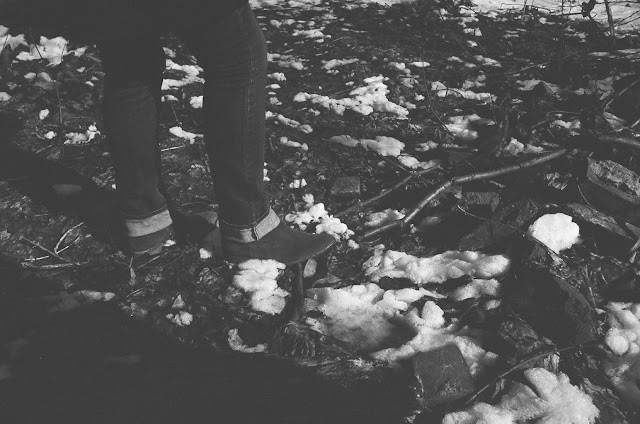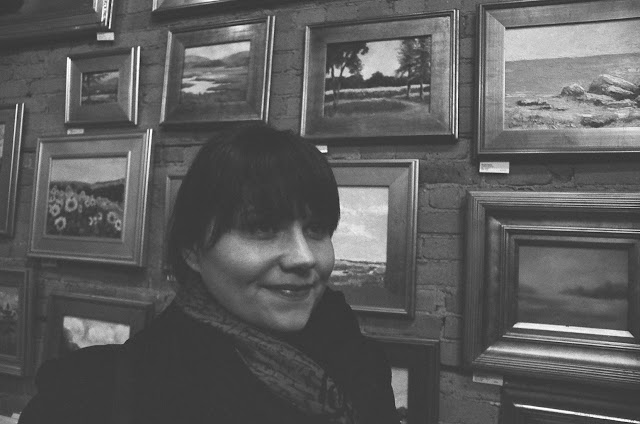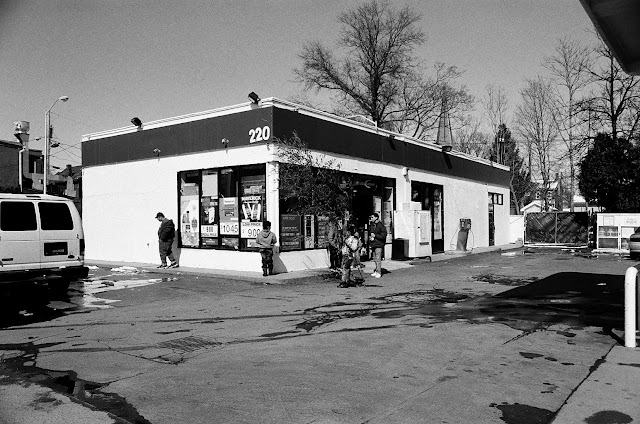
Custom Search
Howdy, Stranger!
It looks like you're new here. If you want to get involved, click one of these buttons!
Categories
- 3.4K All Categories
- 35 Nikon Z lenses
- 80 Nikon Z cameras
- 1.4K Nikon DSLR cameras
- 11 Df
- 237 D6x0/D7x0/D8x0
- 27 D300/D300s/D500
- 29 D3x00
- 45 D3/D4/D5
- 31 D5x00
- 95 D90/D7x00
- 387 Nikon Lenses
- 9 Videos, Nikon et. al.
- 52 Nikon 1
- 18 Nikon Film Cameras
- 56 Nikon Flashes
- 25 Nikon Compact Cameras
- 49 Nikon Software
- 26 Nikon Deals
- 767 General Discussions
- 49 Gear Reviews
- 182 Other Manufacturers
- 105 Fun & Weird
- 128 Photo-a-day
In this Discussion
Who's Online (0)
Push Processing diagnosis
So I am exactly 7 rolls deep on my excursion into film photography. I'm using a Nikon FM2 and I've had some pretty decent results.
The last roll I shot though, almost all of it came back terrible, and I want to figure out what went wrong. I refuse to touch-up any of these photos digitally, as that (in my mind) ruins the spirit of the exercise, but I want to know what you think.
https://picasaweb.google.com/104355103005841782571/NikonFM2Roll7?authuser=0&authkey=Gv1sRgCMOigfevgfqSTg&feat=directlink -- Here are the photos, all together, totally untouched.
All these photos are 400 speed B&W film, that was pushed 3 stops (i.e. I set my camera's meter to 3200) and told the developer (www.thedarkroom.com) to push it 3 stops. All on the same page? Good. I'm very new to push-processing, but my understanding is that it basically allows you to shoot with less available light, at the expense of adding graininess and contrast. However these photos, for the most part, came out mostly a dull dark grey with little definition. A few photos came out well, but they were definitely in the minority:
Exhibit A: A pretty dull photo
Exhibit B: Another photo really lacking in range
Exhibit C: A photo I'm pretty (technically) happy with
So here's my question: What is the most likely cause of this poor job? Is it
a) My lack of skill as a photographer (if so, be specific, as I have many failings)
b) My camera's meter not correctly interpreting 3200 speed (I've found it does a decent job with 400 when I'm not "pushing")
c) The developing company not "pushing" it enough?
d) The scanning company (also the darkroom) somehow messing up the analog/digital conversion
e) All/some/other
This is an album that I shot pushed 2 stops (developed by B&H, not TheDarkroom) that I'm quite happy with: https://picasaweb.google.com/104355103005841782571/NikonFM2Roll6?authuser=0&feat=directlink
Any criticism, constructive or otherwise, is totally welcome.
The last roll I shot though, almost all of it came back terrible, and I want to figure out what went wrong. I refuse to touch-up any of these photos digitally, as that (in my mind) ruins the spirit of the exercise, but I want to know what you think.
https://picasaweb.google.com/104355103005841782571/NikonFM2Roll7?authuser=0&authkey=Gv1sRgCMOigfevgfqSTg&feat=directlink -- Here are the photos, all together, totally untouched.
All these photos are 400 speed B&W film, that was pushed 3 stops (i.e. I set my camera's meter to 3200) and told the developer (www.thedarkroom.com) to push it 3 stops. All on the same page? Good. I'm very new to push-processing, but my understanding is that it basically allows you to shoot with less available light, at the expense of adding graininess and contrast. However these photos, for the most part, came out mostly a dull dark grey with little definition. A few photos came out well, but they were definitely in the minority:
 |
| From Nikon FM2 - Roll 7 |
 |
| From Nikon FM2 - Roll 7 |
 |
| From Nikon FM2 - Roll 7 |
So here's my question: What is the most likely cause of this poor job? Is it
a) My lack of skill as a photographer (if so, be specific, as I have many failings)
b) My camera's meter not correctly interpreting 3200 speed (I've found it does a decent job with 400 when I'm not "pushing")
c) The developing company not "pushing" it enough?
d) The scanning company (also the darkroom) somehow messing up the analog/digital conversion
e) All/some/other
This is an album that I shot pushed 2 stops (developed by B&H, not TheDarkroom) that I'm quite happy with: https://picasaweb.google.com/104355103005841782571/NikonFM2Roll6?authuser=0&feat=directlink
Any criticism, constructive or otherwise, is totally welcome.
Post edited by jjdarling on
www.jjdarling.com
Tagged:
Disclaimer: This site has no affiliation with Nikon Corporation or any of its subsidiary.
Disclosure: [NR] is sponsored by displaying advertising banners and links.
All trademarks and brands belong to their respective owners.
Want to advertise on NikonRumors.com? Contact [NR].
Copyright © 2008-2017 NikonRumors.com.
See our Privacy Policy.
Disclosure: [NR] is sponsored by displaying advertising banners and links.
All trademarks and brands belong to their respective owners.
Want to advertise on NikonRumors.com? Contact [NR].
Copyright © 2008-2017 NikonRumors.com.
See our Privacy Policy.

Comments
But usually the printing process is the part that is messing things up. It depends a lot on how the film is developed and what paper is used for printing. My experience with b&w is that the prints are done on color paper and color negatives usually have a different contrast than b&w one and most of the time the "factory" b&w prints lack contrast.
I was once told that for b&w one very basic rule is: make sure you got some areas with dark blacks and some areas with bright white. Or in more recent terms: make sure you use the entire grey level scale from black to white and not only from dark grey to bright grey.
In my experience b&w really only makes sense if you scan or develop and print on your own. Unless you got a lot of money and you can go to a company that is specialized in b&w printing.
Regarding the printing process, I would think TheDarkroom generally does a good job, as they seem both very knowledgeable and very experienced. They also claim to do "true" B&W printing:
http://thedarkroom.com/black-and-white-prints-and-film-developing/
I'll try them again before writing them off as problematic.
I think ultimately you're right about finding scenes with contrast, in which case it's my skill that's at fault (which is really the default answer), it's just hard to find scenes with a naturally high contrast (or at least readily identify them in the field).
I would love to one day control the entire process, but I figured I'd do it one step at a time, and as long as I'm living in this tiny expensive Manhattan apartment, darkroom equipment is just another set of gear that I don't have space or budget to accommodate.
One thing for sure is that for film, you have to disregard almost everything digital ISO can do. Setting your camera to 3200 was probably 1-2 stops too much. Considering most of your subjects, there was no need for it at all unless you are doing it as an exercise. I found letting the processor push the film about 1 stop was at the limit they were any good at. Beyond that, the images came back terrible. If one was to learn and develop their own images, I'm sure you could do better - but relying on someone else, is giving up a lot of control for what the outcome is.
In the end, I found most of the prints terrible so I scanned all the images and did basic edits to make them somewhat usable. Having the processor (supposedly push the film 1 stop) and with Lightroom/ps basic curves adjustments, I got much closer to what I hoped for. I would suggest getting beyond your thoughts of "no photoshop" since you are actually giving up the actual printing portion of your work flow.
I use to develop and print a contact sheet for 100s of rolls a week, sometimes a day - I don't miss it.
I've mostly block those days from my mind and my age helps that, but I recall an old saw that if you can read the print in a book by laying the negative on the page, the negative is too thin to print on #6 contrast paper, which was hard to get when I was printing, and if the negative is just too black, lacking even any detail at all, it's likely too dense to bring anything to print for the most contrasty papers.
Pushing 3200 from 400, IMMHO, is likely improbably optimistic. While some very, very good effects can come from it, you should start your career in film with what the ISO its intended speed and go from there after a few rolls, and then to a modest 800.
Meter for the shadows, generally, an incident meter would help in this case, or you could just use the camera a reflective meter to get the exposure data, then recompose.
My best,
Mike
My experience was that an ISO 400 film might go to 800, maybe 1200, but beyond this it looks like.....junk.
And, that is what i believe you got....
It's really frustrating when you're used to digital to have to spend so much time and money to learn that the roll turned out badly, but oh well, lessons learned. I think I'll keep experimenting a bit. I would love to, at some point, control the entire process, and then I could do things like this:
http://strobist.blogspot.com/2013/02/how-we-got-here-analog-photoshop.html
This is a recent blog post by David Hobby about how he used to push film for shooting sports for a newspaper. Super interesting.
I would recommend (as others have done before) you start with the given sensitivity and experiment with over and under exposing the film to see how sensitive the process of your lab really is. Then start pushing film slowly, one stop after another to see how you might compensate by over or underexposing the film. For example it might turn out that you will tell the lab to push three stops but you underexpose the film only by 2.5 stops etc.
You might also consider to develop the film by yourself. All you will need is a development tank, some chemicals, a dark room for putting the film from the cartridge into the tank and a dust free room to dry the film. That is not very expensive. Then you might want to look for a decent film scanner (I recommend the Nikon Coolscan series) to scan and post-process the negatives.
Printing negatives using an enlarger is a lot of fun, but very, very time consuming. And you need a little more equipment (enlarger, good optics, darkroom etc) then for just processing the negatives.
and as other say you really need to do everything your self
Just a suggestion; why not try one of these new fangled digital cameras, they are quite good these days and can be pushed to 25,600 ISO. They you will save a fortune in D&P costs
Even with all that we still found that if we got 6-8 publishable shots a roll (and that was a stiff criteria then with newsprints limited ability to show shades of grey) we were damn lucky. Only person I ever saw do it consistently was my PJ professor at USC. He would shoot with us at night football games in horribly lit stadiums and get a full roll of well exposed, nice contrasty shots. Course, he also did his own processing and printing so who knows what sort of alchemy he was cooking up.
@TomB - Others reported success with Ilford, too. I learned from Pete Turner to stick with one film (when I could - and that wasn't my choice more often than not), and try to be consistent in how I worked (and that wasn't a choice I could make either).
That plays well, today, too, inasmuch as working in an ISO at least gives one a notion of the feel of what that ISO will look like as shot.
I make a big deal of the digital darkroom and still do. Souping images still counts. In my book, clicking the shutter is only half the work. If it was good enough for Ansel, and it's good enough for me, too.
My best,
Mike
Souping images! Ugh, haven't heard that phrase in 20 years. Yeah the post stuff is important. I like to try and get things close in camera since I try to put stuff up on my pages while I am in the field. What ever I can do on an iPad is usually first goes. Course with the addition of PS Mobile and Lightroom mobile those first passes are getting better. Just a PITA to get an image from a D4 into an iPad at times.
@TomB - Least I be misunderstood - I loath the thought of going back into a darkroom. I wasn't exaggerating the numbers of rolls. I was a darkroom rat and then a shooter for the US Army in Vietnam and the same for a wire service and newspapers - 3 tanks of 8 rolls each at a time, as many times as there to do in a day that I had time to do them. For a while, I didn't like the taste of pickles. ;-)
I've taught Photoshop in college and university since V3 and other Adobe products, mostly motion and audio and generally to a small audience of people who make their living shooting and editing film or video production. I plan on looking at the mobile products. I'm a bit behind on what they can do, my colleagues are using Behance and Story on mobile and also I'm told there are some ways of moving project files using a new mobile app.
My best,
Mike